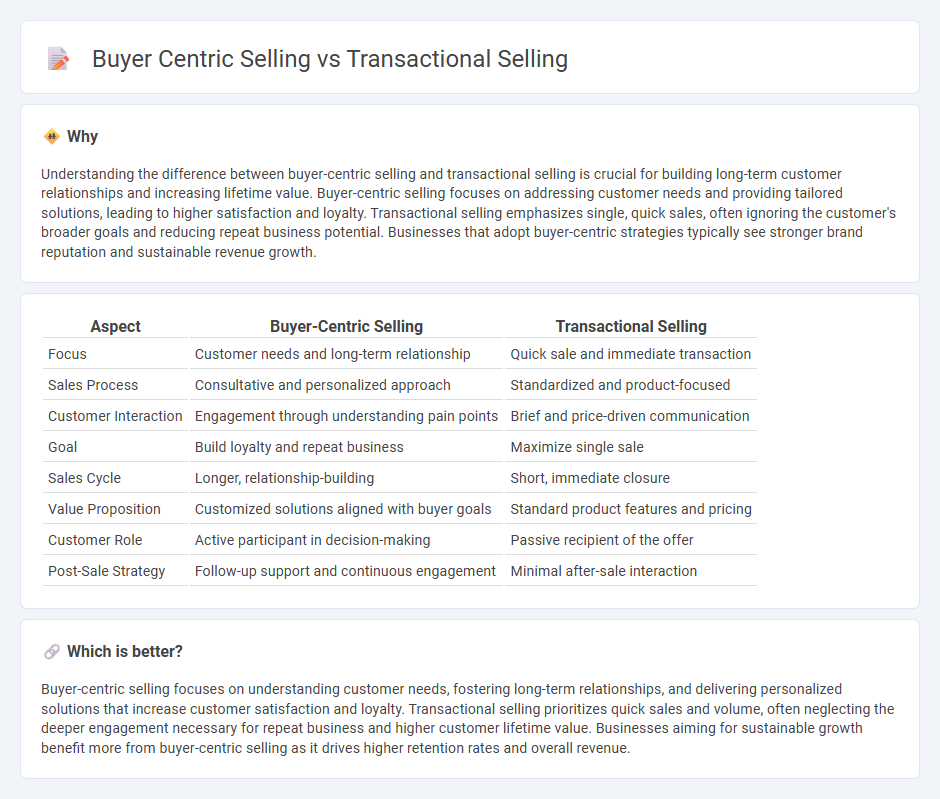
Buyer-centric selling focuses on understanding and addressing the specific needs and pain points of the customer, fostering long-term relationships and trust. Transactional selling prioritizes quick, one-time exchanges with an emphasis on closing the deal rather than building rapport. Discover how shifting to a buyer-centric approach can transform your sales outcomes.
Why it is important
Understanding the difference between buyer-centric selling and transactional selling is crucial for building long-term customer relationships and increasing lifetime value. Buyer-centric selling focuses on addressing customer needs and providing tailored solutions, leading to higher satisfaction and loyalty. Transactional selling emphasizes single, quick sales, often ignoring the customer's broader goals and reducing repeat business potential. Businesses that adopt buyer-centric strategies typically see stronger brand reputation and sustainable revenue growth.
Comparison Table
| Aspect | Buyer-Centric Selling | Transactional Selling |
|---|---|---|
| Focus | Customer needs and long-term relationship | Quick sale and immediate transaction |
| Sales Process | Consultative and personalized approach | Standardized and product-focused |
| Customer Interaction | Engagement through understanding pain points | Brief and price-driven communication |
| Goal | Build loyalty and repeat business | Maximize single sale |
| Sales Cycle | Longer, relationship-building | Short, immediate closure |
| Value Proposition | Customized solutions aligned with buyer goals | Standard product features and pricing |
| Customer Role | Active participant in decision-making | Passive recipient of the offer |
| Post-Sale Strategy | Follow-up support and continuous engagement | Minimal after-sale interaction |
Which is better?
Buyer-centric selling focuses on understanding customer needs, fostering long-term relationships, and delivering personalized solutions that increase customer satisfaction and loyalty. Transactional selling prioritizes quick sales and volume, often neglecting the deeper engagement necessary for repeat business and higher customer lifetime value. Businesses aiming for sustainable growth benefit more from buyer-centric selling as it drives higher retention rates and overall revenue.
Connection
Buyer-centric selling and transactional selling are connected through their shared focus on closing sales but differ in approach and depth. Buyer-centric selling prioritizes understanding customer needs and building long-term relationships, enhancing customer satisfaction and repeat business. Transactional selling, by contrast, emphasizes quick, one-time sales often at the expense of deeper customer engagement, making it a component that buyer-centric selling can integrate for efficiency in certain interactions.
Key Terms
Product-focused
Transactional selling emphasizes quick, one-time product exchanges prioritizing features and price to close sales efficiently. Buyer-centric selling concentrates on understanding the buyer's needs and personalizing the product benefits to enhance customer satisfaction and build long-term relationships. Explore deeper insights into how each approach impacts sales strategy and customer loyalty.
Relationship-building
Transactional selling emphasizes quick sales and immediate exchange, prioritizing product features and price over customer needs. Buyer-centric selling centers on understanding the customer's pain points and building long-term relationships to foster loyalty and repeat business. Explore strategies to enhance relationship-building in your sales approach for sustained success.
Consultative
Consultative selling emphasizes understanding the buyer's specific needs and challenges, offering tailored solutions rather than simply pushing products, unlike transactional selling which prioritizes quick, one-time sales. This buyer-centric approach builds long-term relationships and trust by engaging customers with relevant insights and personalized recommendations. Explore how consultative selling strategies can transform your sales effectiveness and customer satisfaction.
Source and External Links
What is transactional selling, and how does this approach ... - Transactional selling is a sales strategy focused on quickly closing deals by emphasizing competitive pricing, social proof, and urgency without building emotional connections or long-term customer relationships.
Transactional selling: Strategy, definition and how it works - This sales strategy aims to drive immediate revenue through quick, one-time sales with minimal personalization, using scarcity, urgency, and promotional offers to close deals rapidly.
The One-Call Close: A guide to transactional sales - Transactional selling focuses on speed and efficiency to close deals quickly with minimal touchpoints, supporting high sales volume and freeing sales teams to concentrate on more strategic deals.
 dowidth.com
dowidth.com